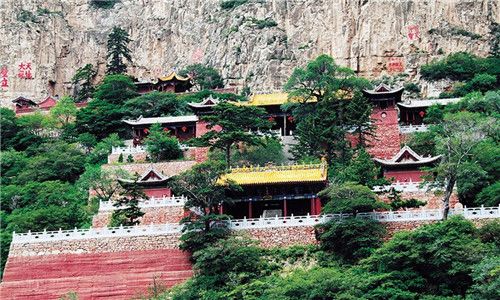Religious significance of Hengshan
 0 Comment(s)
0 Comment(s) Print
Print E-mail Shanghai Daily, November 17, 2015
E-mail Shanghai Daily, November 17, 2015

The endless sea of clouds, time-honored plank roads, spectacular hanging temples and magnificent slopes covered by pines and hemlocks have made the Hengshan National Park in Shanxi Province a "must-go" among the numerous mountainous scenic spots in China.
Not to be confused with the Hengshan in Hunan Province, both of which are among the Five Great Mountains in China, Mount Heng in Shanxi is often called as the Northern Hengshan, while the Southern Hengshan refers to the one in Hunan. The history of the Northern Hengshan dates back to the Zhou Dynasty (1076-249 BC) when it was first recorded as a sacred mountain because of its Taoist presence — thus standing out for having the longest history among the Five Great Mountains.
However, due to its northerly location, Hengshan was often under the control of foreigners which led to a weaker history of pilgrimage than the other four. Even today, the Northern Hengshan is less commercialized than the other mountains or Taoist scenic spots.
Nevertheless, the Northern Hengshan has religious significance just like the other sacred mountains. The Beiyue Temple and the Hanging Temple are two must-visit places when traveling to Hengshan. The Beiyue Temple was first established in early Tang Dynasty (AD 618-907) and rebuilt twice (first in AD 991, and then in 1270). It was used by emperors to make sacrifice to Hengshan, especially when the peak was occupied by non-Chinese authorities.
The Hanging Temple, built 75 meters above the ground, is notable not only for its incredible location on the precipice, but also for the fact that it is the only existing temple with a combination of three Chinese religions: Buddhism, Taoism and Confucianism. More astonishingly, this temple is believed to be built by only one man — a monk named Liao Ran — over 1,600 years ago.
Hengshan is also famous for 18 scenic views. Collectively, they demonstrate the picturesque beauty from the foot to the peak and have attracted visitors from home and abroad.
The Dragon Spring is a pair of wells. One tastes pure and sweet, while the other one is bitter and harsh. In Tang Dynasty, Emperor Li Longji named it as the Dragon Spring. Since then, visitors travel to the mountain only to have a sip of the water from the Dragon Spring and be blessed with good luck.
The Hanging Pine is a pine that grows on the bare rocks of a sheer cliff. The wind blows so fiercely that it creates a sound of tiger's growl. Yet despite the strong wind, the pine stands incredibly high as if hanging in the sky.
The Sunset Cliff is the place to enjoy the stunning beauty of sunset.






